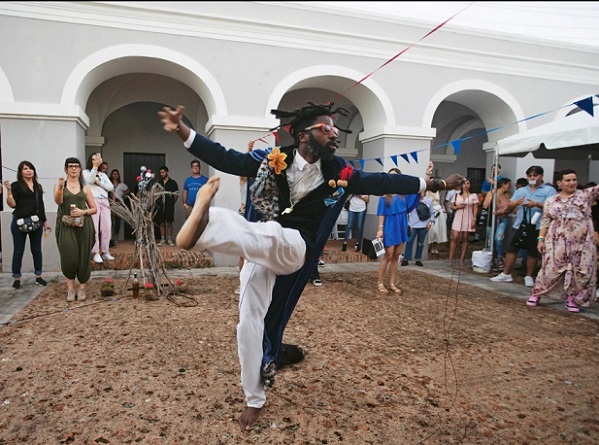[Many thanks to Veerle Poupeye (Critical.Caribbean.Art) for bringing this item to our attention.] With stunning photography, including portraits by Erica MacLean, Sophie Lucido Johnson (MFA 2017) reviews the work of Nyugen E. Smith for The School of the Art Institute of Chicago magazine. [Photo above by Raquel Peréz-Puig: Still from the performance Lest We Forget (Puerto Rico)]
To try to summarize Nyugen E. Smith’s (MFA 2016) oeuvre would be a fool’s errand. His work is too vast and too full; it spans every conceivable art form and is at once about the universal experience of being alive and the specific experience of being a first-generation American born to parents from Caribbean countries.
“I’ve been rethinking ways that I talk about the work,” Smith said of his own artistic practice. When we spoke, he was in Washington, DC, finalizing work for the cumulative performance for the CulturalDC Capital Artist Residency, of which he is the second-ever recipient. As he polishes off three months of work that ranged from writing to mixed-media work on paper to found objects to sculpture to performance, Smith thinks it might be time for him to change his elevator pitch.
He used to tell people he was an interdisciplinary artist who primarily made mixed-media works, focusing on the impact of colonialism in the African diaspora. But in some ways, these days that description feels too broad; in other ways, it’s too narrow.
“That broad umbrella gives me room to play. And within this play, I’m able to learn new histories by researching and investigating, and continuing to make this work,” Smith said. And that makes sense: so much of Smith’s work is deeply grounded in histories that have been stifled or erased. His way of carefully investigating these histories through language, materials, and construction has made his work definitive and singularly about the experience of African descendants. At the same time, its core is the human experience.
Smith’s father is from Haiti and his mother is from Trinidad and Tobago, where he spent his formative years. As a child in Trinidad, Smith absorbed cultural care around processes and materials in craftsmanship. Smith’s grandfather built cabinets, his uncle taught him how to draw, and his whole family built and maintained a large hand-crafted chicken coop. His childhood home was filled with handmade art, objects, carvings, and reliefs, imbuing Smith with a sense of understanding of where things come from.
“When you know the person who made something, you’re not just seeing it as an object, but it had a personality and a history that you could trace. It wasn’t something that came from a faceless store or a factory,” Smith said.
When he was eight, Smith moved to live with his mother in Jersey City. In the US, Smith’s mother took him and his brother to see African dance performances, art exhibitions, museums, studios, and Kwanzaa festivals. She made clear to her sons the importance of both the arts and their Caribbean heritage. [. . .]
[. . .] Today, Smith has worked in every conceivable material and style. His Bundle Houses led to a series of pieces called Spirit Carriers—found object constructions that were presented suspended from the ceiling. He designed and created flags to signify real independence and Black/Caribbean claims for reparations, which culminated in a performance in Martinique. He worked in two-dimensional collage, huge porcelain installations, multimedia drawing, photography, language, music, video, theory, and on and on and on. He even created (or maybe, rather, distilled) a language related to Haitian Creole, which will be developed into a musical notation system. Smith’s work exemplifies the word “boundless.”
But the purpose that Smith sensed when he initially conceptualized his Bundle Houses is still clear: if anything, it’s stronger than ever. He is bringing an intentional artistic voice and awareness to the trauma, resilience, spirit, violence, and memory of both ancestral and living people in the Black African diaspora. Smith’s work refuses to look away from what is painful: he insists on holding both the beauty and the violence; the destruction and the survival; the inhumane and the human.
For the full article and an amazing array of photos, see https://www.saic.edu/magazine/spring23/the-indefinable-nyugen-smiths-explosive-artistry


One thought on “The Indefinable Nyugen E. Smith’s Explosive Artistry”